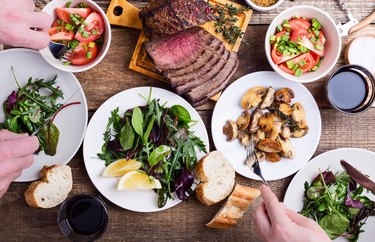How Eat-Stop-Eat Works, and the Pros and Cons to Know

istetiana/Moment/GettyImages
Weight-loss guru Brad Pilon based his “Eat Stop Eat” plan on the theory of intermittent fasting, which focuses on when you eat rather than calories or restricting certain foods.
Pilon’s plan involves fasting up to twice a week, and it does not require you to give up any specific food group. This type of regimen does have drawbacks, though, and may not be for everyone.
Video of the Day
Video of the Day
Here, we explore what the diet actually is, its guidelines around food, the pros and cons and — ultimately — whether you should try it.
Tip
Keep in mind there’s not one form of eating that is best for everyone. Your diet should be geared toward what works best for your lifestyle and health needs.
What Is the Eat-Stop-Eat Diet?
The Eat-Stop-Eat diet is a type of intermittent fasting — aka time-restricted eating. Eat-Stop-Eat falls into the “alternate-day fasting” form of IF. That’s because on the Eat-Stop-Eat diet, you fast once or twice a week, ideally with a complete break from food for 24 hours at a time. For example, you might eat normally until 7 p.m. on a Saturday, then fast until 7 p.m. on Sunday, at which point you can go back to your regular eating pattern.
That said, there is some flexibility: If you can’t make it the full 24 hours, Pilon says anywhere between 20 and 24 hours will work.
You should never fast on consecutive days, and you shouldn’t exceed two fasts in any one week. In fact, fasting just once a week could still be beneficial, as you’ll create about a 10 percent calorie deficit, Pilon says.
What Can You Eat on Eat-Stop-Eat?
On your fasting days, take in as few calories as possible, but make sure to stay hydrated.
Drinks to Have When Fasting
- Water
- Black coffee
- Herbal and green teas, and special fasting teas
like ESE Tea - Sparkling water
- Any other drink that is
close to zero calories
On your eating days, you can eat whatever you like, but Pilon emphasizes the importance of moderation, because overeating could undo the benefits of the fast. Aim to get anywhere from 2,000 to 2,500 calories per day depending on your nutrition needs, per the National Health Service.
If you find you’re gaining weight between fasts, Pilon says to cut your food consumption back by 10 percent on non-fasting days.
You do not have to avoid any specific foods or food groups, such as carbs. In fact, Pilon says a low-carb diet on non-fasting days may negatively affect your energy levels. The following food groups are ones that Pilon suggests you focus on — with protein being very specific.
Foods to Eat on Non-Fasting Days
- Fruits
- Vegetables
- Spices
- Protein: 20 to 30 grams every four to five hours for
a daily total of 100 grams
Foods to Avoid on Non-Fasting Days
- None
Does It Help With Weight Loss?
The short answer is, it can. According to Pilon, brief, regular fasts promote weight loss and maintain muscle better than diets that eliminate certain foods or cut your number of daily calories. But the research determining whether regular dieting or intermittent fasting is better for weight loss is mixed.
For example, a December 2015 review in Molecular and Cellular Endocrinology states that intermittent fasting often produces the same effects as continuous calorie restriction to lose weight, and an August 2023 meta-analysis in Nutrition, Metabolism & Cardiovascular Diseases found that intermittent fasting is not associated with greater or lesser weight loss than non-intermittent fasting diets.
The key to intermittent fasting diets (or any diet, really) is that it feels sustainable. If you’re finding it difficult to keep weight off long term, then the diet you’ve chosen may not be right for you. In fact, a February 2020 review from The College of Family Physicians of Canada determined that longer-term research is needed to understand the sustainability role intermittent fasting can play in weight loss.
Can You Exercise on Eat-Stop-Eat?
Yes, but Pilon suggests starting with resistance or weight-training exercises so you can maintain and build muscle. You can also try low-impact cardio like walking.
He advises against high-intensity cardio like running and other exhaustive forms of exercise until you’re more established in your Eat-Stop-Eat way of living.
On the days you are fasting, skip exercise.
The Pros of Eat-Stop-Eat
Here, we’ll take a look at the positives when it comes to this weight-loss diet:
1. Easy to Follow
This is the biggest benefit to Eat-Stop-Eat. It doesn’t come with many rules, and it’s more straightforward than diets in which you have to limit an entire food group, like fat or carbs.
2. Claims Are Supported by Research
Unlike fad diets that promise super-quick weight loss and have zero science to back them up, there’s research to support that Eat-Stop-Eat can help you lose weight and keep it off, and that it’s likely to help you maintain muscle as you lose weight.
3. Lowers Inflammatory Markers
Following an intermittent fasting diet has been shown to improve various different markers of inflammation — such as leptin, adiponectin and c-reactive protein — per a March 2019 study in Nutrients. And chronic inflammation is linked to many chronic, even debilitating diseases.
4. Supports Heart Health
Blood pressure and cholesterol levels both affect your heart health, and following an intermittent fasting diet like Eat-Stop-Eat (aka alternate-day fasting) has been shown to lower blood pressure and improve blood lipids, per the same March 2019 Nutrients review, mostly lowering total cholesterol and LDL cholesterol.
The Cons of Eat-Stop-Eat
Here are some of the drawbacks of the diet to consider:
1. May Not Fit Your Lifestyle
Fasting for 24-hour time periods each week can interfere with family meals and social interactions with friends that may be based around meals or drinks.
2. Loose Guidelines
Another con is that Eat-Stop-Eat doesn’t make any specific meal-plan recommendations for non-fasting days, leaving you to demonstrate enormous self-control and also judge for yourself what to eat. Many people who struggle with their weight need guidance on what to eat, not just when to eat.
3. Possible Side Effects
Transitioning into an Eat-Stop-Eat way of eating may also be challenging. In the beginning, it’s common to experience bad moods, fatigue and dizziness. Experts say this is because your body needs time to get used to using ketones instead of glucose as an energy source.
So, Should You Try Eat-Stop-Eat?
Intermittent fasting — including the Eat-Stop-Eat approach — has some that shows it does help with weight loss and preventing weight gain. However, it can produce the same effect as any other type of diet plan.
Another perk: Intermittent fasting diets may also lower your risk of chronic diseases. (Check out the research around fasting and autophagy.)
If a diet that includes fasting for 20 to 24 hours once or twice a week feels feasible for your lifestyle, then Eat-Stop-Eat may be worth trying. That said, if you have diabetes, are pregnant or have a history of an eating disorder, this diet may not appropriate for you. Talk to your doctor before trying any weight-loss diet.




